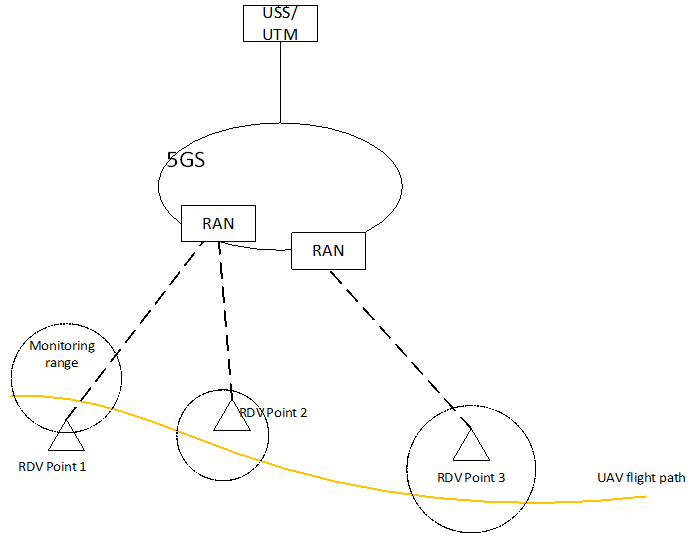Content for TR 22.843 Word version: 19.2.0
5.7 Use case on UAV flight route tracking at Rendezvous points
5.7.1 Description
5.7.2 Pre-conditions
5.7.3 Service Flows
5.7.4 Post-conditions
5.7.5 Existing features partly or fully covering the use case functionality
5.7.6 Potential New Requirements needed to support the use case
...
...
5.7 Use case on UAV flight route tracking at Rendezvous points p. 18
5.7.1 Description p. 18
Commercial UAV flights are usually BVLOS. Tracking the UAV flights to ensure that they are sticking to the planned route is critical to the success of the mission and the safety of the public. For UAVs that have network communication capability, cellular networks can greatly assist in UAV flight route tracking thanks to their ubiquitous network coverage. However, there are UAVs in the markets today that lack 5G network connection capabilities and probably will remain so for a long time. For such non-networked UAVs, ground stations or stationary devices can provide means to UTM/UAV operator in flight route tracking.
Ground stations or stationary devices can be operated by the 5G network operator which has service agreements with the USS/UTM or by a third-party service provider. The ground stations or stationary devices are deployed along popular flight routes. The UTM/UAV operator can have a need to track the flight route of a non 3GPP capable UAVs using the assistance of 5G network and ground station devices to further enhance the safety and security of UAV operations (e.g., for DAA) while also supporting legacy UAVs.

5.7.2 Pre-conditions p. 19
A USS/UTM provides environmental surveillance services in an area. It regularly sends out UAVs to fly a planned route collecting environmental data. The UAV is not the subscriber UE of the 5G cellular network operator and can be considered as non-networked UAV for the 5G operator.
A 5G cellular network operator provides 5G network services in the area.
A 5G cellular network operator provides UAV tracking service in the area. For example, it has several ground stations or stationary devices deployed in strategic areas (e.g., along popular flight routes, close to important infrastructure as airports). The ground stations or stationary devices are capable of 5G connectivity and also detection or communication with non-networked UAVs using e.g. 5G device-to-device communication technologies. The 5G network operator has access to information about the available ground stations.
The technologies for detection of any UAV along a flight route is outside the scope of the use-case, however the tracking mechanisms for specific UAV needs to support unambiguous identification of the UAVs to ensure reliable and accurate tracking data about the UAV.
5.7.3 Service Flows p. 19
- The USS/UTM requests tracking of one of more UAVs from the 5G operator.
- The 5G network to track those non-network UAVs. The USS/UTM provides the planned flight route information to the 5G network (e.g., waypoints, ETA).
- The 5G network start to track those UAV, such as requests selected ground stations to monitor the presence of the target UAVs in its proximity. The ground stations monitor the UAV flight route based on the available information about the planned flight route.
- When a ground station detects and identifies the target UAV in its proximity, e.g., by receiving BRID information from the target UAV, the ground station in the 5G network informs the UTM that the UAV is following the planned route.
- At estimated time-of-arrival (ETA), the relevant ground station(s) monitor the presence of the target UAV in its proximity and the 5G network informs the UTM that the UAV has completed its flight as scheduled.
5.7.4 Post-conditions p. 19
The UAV finishes the mission with USS/UTM reassured during the whole flight.
5.7.5 Existing features partly or fully covering the use case functionality p. 19
Identification of UAVs which don't have subscription with the 5G operator for DAA has been specified in Rel-18. Tracking for such UAVs is currently not covered in Rel-18 because release 18 only supports the capability to allow the 5G operator tracking of those UAVs which have the subscription with the 5G operator.
5.7.6 Potential New Requirements needed to support the use case p. 19
[P.R 5.7.6-001]
The 5G system shall be able to support a mechanism to enable a network operator to track a UAV which doesn't have subscription with this network operator.